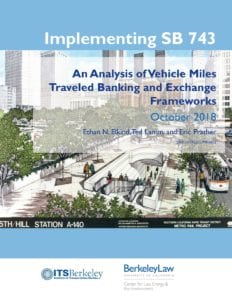Mitigating Increased Driving Miles From New Projects Under CEQA
New Berkeley Law/CLEE report released today; Webinar discussion on Tuesday, October 30th
 California law now requires developers of new projects, like apartment buildings, offices, and roads, to reduce the amount of overall driving miles the projects generate. Senate Bill 743 (Steinberg, 2013) authorized this change in the method of analyzing transportation impacts under the California Environmental Quality Act (CEQA), from auto delay to vehicle miles traveled (VMT).
California law now requires developers of new projects, like apartment buildings, offices, and roads, to reduce the amount of overall driving miles the projects generate. Senate Bill 743 (Steinberg, 2013) authorized this change in the method of analyzing transportation impacts under the California Environmental Quality Act (CEQA), from auto delay to vehicle miles traveled (VMT).
In response to SB 743, some state and local leaders are seeking to create special “banks” or “exchanges” to allow developers to fund off-site projects that reduce VMT, such as new bike lanes, transit, and busways. These options could be useful when the developers lack sufficient on-site mitigation options.
A new report from Berkeley Law’s Center for Law, Energy and the Environment (CLEE), Implementing SB 743, provides a comprehensive review of key legal and policy considerations for local and regional agencies tasked with crafting these innovative mechanisms, including:
- Legal requirements under CEQA and Constitutional case law;
- Criteria for mitigation project selection and prioritization;
- Methods to verify VMT mitigation and “additionality”; and
- Measures to ensure equitable distribution of projects.
The report recommends that decision makers launching new VMT banks and exchanges consider including:
- Measures to verify the legitimacy of claimed VMT reductions, as well as their “additionality”;
- Prioritization of individual mitigation projects, in order to ensure that reductions are achieved as quickly and efficiently;
- Rigorous backstops to ensure that disadvantaged communities are not negatively impacted by—and ideally can benefit from—the ability of developers to move mitigation off-site; and
- Demonstration of both a reasonable substantive relationship and financial proportionality between the proposed development and the fee or condition placed on it.
Ultimately, SB 743 implementation will require a range of approaches from jurisdictions of varying sizes, densities, and development patterns throughout California. Local, regional, or even statewide mechanisms may evolve as mitigation programs mature and potential efficiencies are identified. Implementing SB 743 offers a guidebook to agencies and developers navigating the law’s new approach.
For more information, join CLEE’s webinar on Tuesday, October 30th from 10-11am with Governor’s Office of Planning and Research senior planner Chris Ganson and report co-author Ted Lamm and me. You can register for the free webinar today.






Reader Comments